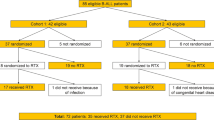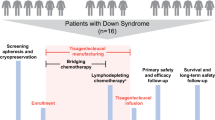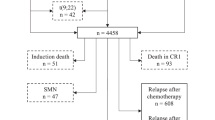Abstract
Hyperglycemia adversely affects outcome in adult patients with acute lymphoblastic leukemia (ALL), but its impact on children with this disease is unknown. We evaluated the relationship between hyperglycemia during remission induction therapy and clinical outcomes among pediatric patients with ALL. We reviewed the records of patients enrolled on four consecutive ALL protocols (Total Therapy protocols XIIIA, XIIIB, XIV and XV) at St Jude Children's Research Hospital from 1991 to 2007 and identified those who experienced hyperglycemia (glucose ⩾200 mg per 100 ml) during remission induction. Complete remission (CR) rates at the end of induction, event-free survival (EFS), overall survival (OS), cumulative incidence of relapse and occurrence of infections were compared between those who did and did not experience hyperglycemia. Of 871 patients analyzed, 141 (16%) experienced hyperglycemia during remission induction. Patients with hyperglycemia were significantly older than the other patients (P<0.0001). There was no significant difference in CR rate (P=0.92), EFS (P=0.80), OS (P=0.28), cumulative incidence of relapse (P=0.59) or in the probability or types of infection between patients who did and did not experience hyperglycemia. Pediatric patients with or without hyperglycemia during remission induction for ALL have similar clinical outcome. Occurrence of hyperglycemia does not warrant alteration of the antileukemic regimen.
This is a preview of subscription content, access via your institution
Access options
Subscribe to this journal
Receive 12 print issues and online access
$259.00 per year
only $21.58 per issue
Buy this article
- Purchase on Springer Link
- Instant access to full article PDF
Prices may be subject to local taxes which are calculated during checkout



Similar content being viewed by others
References
Iyer RS, Rao SR, Pai S, Advani SH, Magrath IT . -Asparaginase related hyperglycemia. Indian J Cancer 1993; 30: 72–76.
Jaffe N, Traggis D, Das L, Frauenberger G, Hann HW, Kim BS et al. Favorable remission induction rate with twice weekly doses of L-asparaginase. Cancer Res 1973; 33: 1–4.
Jaffe N, Traggis D, Das L, Kim BS, Won H, Hann L et al. Comparison of daily and twice-weekly schedule of L-asparaginase in childhood leukemia. Pediatrics 1972; 49: 590–595.
Lavine RL, DiCinto DM . -Asparaginase diabetes mellitus in rabbits: differing effects of two different schedules of L-asparaginase administration. Horm Metab Res 1984; 16 (Suppl 1): 92–96.
Lavine RL, Brodsky I, Garofano CD, Rose LI . The effect of E. coli L-asparaginase on oral glucose tolerance and insulin release in man. Diabetologia 1978; 15: 113–116.
Lavine RL, DiCintio DM . Glucose tolerance an insulin release in L-asparaginase treated rabbits. Metabolism 1980; 29: 1262–1266.
Lavine RL, DiCintio DM . -Asparaginase-induced diabetes mellitus in rabbits. Diabetes 1980; 29: 528–531.
Varsano I, Zaizov R, Nitzan M . Persistent diabetes and ketoacidosis due to L-asparaginase therapy. Helv Paediatr Acta 1973; 28: 365–369.
Wang YJ, Chu HY, Shu SG, Chi CS . Hyperglycemia induced by chemotherapeutic agents used in acute lymphoblastic leukemia: report of three cases. Zhonghua Yi Xue Za Zhi (Taipei) 1993; 51: 457–461.
Baillargeon J, Langevin AM, Mullins J, Ferry Jr RJ, DeAngulo G, Thomas PJ et al. Transient hyperglycemia in hispanic children with acute lymphoblastic leukemia. Pediatr Blood Cancer 2005; 45: 960–963.
Howard SC, Pui CH . Endocrine complications in pediatric patients with acute lymphoblastic leukemia. Blood Rev 2002; 16: 225–243.
Pui CH, Burghen GA, Bowman WP, Aur RJ . Risk factors for hyperglycemia in children with leukemia receiving L-asparaginase and prednisone. J Pediatr 1981; 99: 46–50.
Faustino EV, Apkon M . Persistent hyperglycemia in critically ill children. J Pediatr 2005; 146: 30–34.
Finney SJ, Zekveld C, Elia A, Evans TW . Glucose control and mortality in critically ill patients. JAMA 2003; 290: 2041–2047.
Srinivasan V, Spinella PC, Drott HR, Roth CL, Helfaer MA, Nadkarni V . Association of timing, duration, and intensity of hyperglycemia with intensive care unit mortality in critically ill children. Pediatr Crit Care Med 2004; 5: 329–336.
van den BG, Wouters P, Weekers F, Verwaest C, Bruyninckx F, Schetz M et al. Intensive insulin therapy in the critically ill patients. N Engl J Med 2001; 345: 1359–1367.
Wintergerst KA, Buckingham B, Gandrud L, Wong BJ, Kache S, Wilson DM . Association of hypoglycemia, hyperglycemia, and glucose variability with morbidity and death in the pediatric intensive care unit. Pediatrics 2006; 118: 173–179.
Umpierrez GE, Isaacs SD, Bazargan N, You X, Thaler LM, Kitabchi AE . Hyperglycemia: an independent marker of in-hospital mortality in patients with undiagnosed diabetes. J Clin Endocrinol Metab 2002; 87: 978–982.
Gore DC, Chinkes D, Heggers J, Herndon DN, Wolf SE, Desai M . Association of hyperglycemia with increased mortality after severe burn injury. J Trauma 2001; 51: 540–544.
Grey NJ, Perdrizet GA . Reduction of nosocomial infections in the surgical intensive-care unit by strict glycemic control. Endocr Pract 2004; 10 (Suppl 2): 46–52.
Manzoni P, Castagnola E, Mostert M, Sala U, Galletto P, Gomirato G . Hyperglycaemia as a possible marker of invasive fungal infection in preterm neonates. Acta Paediatr 2006; 95: 486–493.
Bagdade JD, Root RK, Bulger RJ . Impaired leukocyte function in patients with poorly controlled diabetes. Diabetes 1974; 23: 9–15.
Black CT, Hennessey PJ, Andrassy RJ . Short-term hyperglycemia depresses immunity through nonenzymatic glycosylation of circulating immunoglobulin. J Trauma 1990; 30: 830–832.
Gregory R, McElveen J, Tattersall RB, Todd I . The effects of 3-hydroxybutyrate and glucose on human T cell responses to Candida albicans. FEMS Immunol Med Microbiol 1993; 7: 315–320.
Reinhold D, Ansorge S, Schleicher ED . Elevated glucose levels stimulate transforming growth factor-beta 1 (TGF-beta 1), suppress interleukin IL-2, IL-6 and IL-10 production and DNA synthesis in peripheral blood mononuclear cells. Horm Metab Res 1996; 28: 267–270.
Losser MR, Bernard C, Beaudeux JL, Pison C, Payen D . Glucose modulates hemodynamic, metabolic, and inflammatory responses to lipopolysaccharide in rabbits. J Appl Physiol 1997; 83: 1566–1574.
Chiaretti A, Piastra M, Pulitano S, Pietrini D, De RG, Barbaro R et al. Prognostic factors and outcome of children with severe head injury: an 8-year experience. Childs Nerv Syst 2002; 18: 129–136.
Cochran A, Scaife ER, Hansen KW, Downey EC . Hyperglycemia and outcomes from pediatric traumatic brain injury. J Trauma 2003; 55: 1035–1038.
Hall NJ, Peters M, Eaton S, Pierro A . Hyperglycemia is associated with increased morbidity and mortality rates in neonates with necrotizing enterocolitis. J Pediatr Surg 2004; 39: 898–901.
Yates AR, Dyke PC, Taeed R, Hoffman TM, Hayes J, Feltes TF et al. Hyperglycemia is a marker for poor outcome in the postoperative pediatric cardiac patient. Pediatr Crit Care Med 2006; 7: 351–355.
Graubner UB, Porzig S, Jorch N, Kolb R, Wessalowski R, Escherich G et al. Impact of reduction of therapy on infectious complications in childhood acute lymphoblastic leukemia. Pediatr Blood Cancer 2008; 50: 259–263.
Rubnitz JE, Lensing S, Zhou Y, Sandlund JT, Razzouk BI, Ribeiro RC et al. Death during induction therapy and first remission of acute leukemia in childhood: the St Jude experience. Cancer 2004; 101: 1677–1684.
Slats AM, Egeler RM, van der Does-van den Berg A, Korbijn C, Hahlen K, Kamps WA et al. Causes of death--other than progressive leukemia--in childhood acute lymphoblastic (ALL) and myeloid leukemia (AML): the Dutch Childhood Oncology Group experience. Leukemia 2005; 19: 537–544.
Wheeler K, Chessells JM, Bailey CC, Richards SM . Treatment related deaths during induction and in first remission in acute lymphoblastic leukaemia: MRC UKALL X. Arch Dis Child 1996; 74: 101–107.
Boren J, Cascante M, Marin S, Comin-Anduix B, Centelles JJ, Lim S et al. Gleevec (STI571) influences metabolic enzyme activities and glucose carbon flow toward nucleic acid and fatty acid synthesis in myeloid tumor cells. J Biol Chem 2001; 276: 37747–37753.
Boros LG, Lee WN, Go VL . A metabolic hypothesis of cell growth and death in pancreatic cancer. Pancreas 2002; 24: 26–33.
Weiser MA, Cabanillas ME, Konopleva M, Thomas DA, Pierce SA, Escalante CP et al. Relation between the duration of remission and hyperglycemia during induction chemotherapy for acute lymphocytic leukemia with a hyperfractionated cyclophosphamide, vincristine, doxorubicin, and dexamethasone/methotrexate-cytarabine regimen. Cancer 2004; 100: 1179–1185.
Pui CH, Mahmoud HH, Rivera GK, Hancock ML, Sandlund JT, Behm FG et al. Early intensification of intrathecal chemotherapy virtually eliminates central nervous system relapse in children with acute lymphoblastic leukemia. Blood 1998; 92: 411–415.
Pui CH, Sandlund JT, Pei D, Campana D, Rivera GK, Ribeiro RC et al. Improved outcome for children with acute lymphoblastic leukemia: results of Total Therapy Study XIIIB at St Jude Children's Research Hospital. Blood 2004; 104: 2690–2696.
Kishi S, Griener J, Cheng C, Das S, Cook EH, Pei D et al. Homocysteine, pharmacogenetics, and neurotoxicity in children with leukemia. J Clin Oncol 2003; 21: 3084–3091.
Pui CH, Relling MV, Sandlund JT, Downing JR, Campana D, Evans WE . Rationale and design of Total Therapy Study XV for newly diagnosed childhood acute lymphoblastic leukemia. Ann Hematol 2004; 83 (Suppl 1): S124–S126.
Kaplan EL, Meier P . Nonparametric estimation from incomplete data observations. J Am Stat Assoc 1958; 53: 457–481.
Mantel N . Evaluation of survival data and two new rank order statistics arising in its consideration. Cancer Chemother Rep 1966; 50: 163–170.
Cox DR . Regression models and lifetables. J R Stat Soc[B] 1972; 34: 187–220.
Kalbfeisch JD, Prentice RL . The Statistical Analysis of Failure Time Data. John Wiley: New York, 1980, pp 163–188.
Gray RJ . A class of K-sample tests for comparing the cumulative incidence of a competing risk. Ann Stat 1988; 16: 1141–1154.
Roberson JR, Raju S, Shelso J, Pui CH, Howard SC . Diabetic ketoacidosis during therapy for pediatric acute lymphoblastic leukemia. Pediatr Blood Cancer 2008; 50: 1207–1212.
Kantarjian HM, OÆBrien S, Smith TL, Cortes J, Giles FJ, Beran M et al. Results of treatment with hyper-CVAD, a dose-intensive regimen, in adult acute lymphocytic leukemia. J Clin Oncol 2000; 18: 547.
Yang L, Panetta JC, Cai X, Pei D, Cheng C, Kornegay N et al. Asparaginase may influence dexamethasone pharmacokinetics in acute lymphoblastic leukemia. J Clin Oncol 2008; 26: 1932–1939.
Powers AC . Diabetes Mellitus. In: Kasper DL, Fauci AS, Longo DL, Braunwald E, Hauser SL, Jameson JL, et al., (eds). Harrison's Principles of Internal Medicine, 17 edn. McGraw-Hill: New York, 2008.
Acknowledgements
This study was supported by grants (CA-21765, CA-51001, CA-36401, CA-78224, CA-60419, GM-61393) from the National Institutes of Health, and by the American Lebanese Syrian Associated Charities. Dr Pui is an American Cancer Society Professor.
Author information
Authors and Affiliations
Corresponding author
Rights and permissions
About this article
Cite this article
Roberson, J., Spraker, H., Shelso, J. et al. Clinical consequences of hyperglycemia during remission induction therapy for pediatric acute lymphoblastic leukemia. Leukemia 23, 245–250 (2009). https://doi.org/10.1038/leu.2008.289
Received:
Revised:
Accepted:
Published:
Issue Date:
DOI: https://doi.org/10.1038/leu.2008.289
Keywords
This article is cited by
-
The Adolescent and Young Adult with Cancer: State of the Art-- Acute Leukemias
Current Oncology Reports (2013)
-
Medication induced diabetes during induction in pediatric acute lymphoblastic leukemia: prevalence, risk factors and characteristics
Supportive Care in Cancer (2012)



